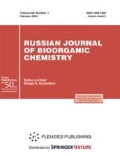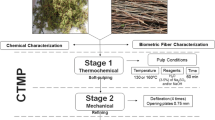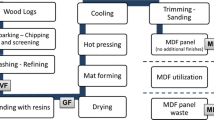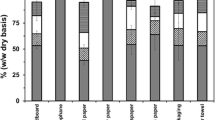Abstract
Utilization of paper wastes as renewable resource of lignocellulosic constituents has the opportunity to promote a cleaner environment and to prepare valuable materials. This paper describes our study on an isolation of low-fiber powder cellulose from two grades of wastes as feedstocks: waste newsprint paper and cardboard wrapper through recycling including a thermal defibration, an alkali treatment with a solution of NaOH with a concentration from 0.03 to 1.00 М, bleaching with a solution of Н2О2 with a concentration from 0.8 to 2.6 М followed with an acid hydrolysis of the pretreated species with a solution of HNO3 of 1.5 and 3.0 M. The impact of the pretreatment on sizes of fibers was evaluated with stereoscopic microscopy. The powder celluloses obtained as a result of the acid hydrolysis exhibited the structure of cellulose I revealed with a WAXS method and were of a high-grade purity, according to EDXA. Sorption capacities of the powder celluloses from the waste cardboard and newsprint towards a dye methylene blue were 6.67 and 8.75 mg g–1, respectively.





Similar content being viewed by others
REFERENCES
Abitbol, T., Rivkin, A., Cao, Y., Nevo, Y., Abraham, E., et al., Nanocellulose, a tiny fiber with huge applications, Curr. Opin. Biotechnol., 2016, vol. 39, pp. 76–88.
Klemm, D., Kramer, F., Moritz, S., Lindstrom, T., Ankerfors, M., et al., Reviews nanocelluloses: A new family of nature-based materials, Angew. Chem., Int. Ed. Engl., 2011, vol. 50, .
Kotelnikova, N.E., Effect of thermal and mechanochemical degradation on the structure and morphology of cellulose, in Struktur und Reaktivitat der Cellulose: Thes. VII Int. Arbeitseminar. Reinhardsbrunn, DDR, 1988, pp. 91–110.
Petropavlovskii, G.A., Kotel’nikova, N.E., Vasil’eva, V.V., and Volkova, V.A., Some effects of the cellulose structure, Cellulose Chem. Technol., 1971, vol. 2, no. 5, pp. 105–116.
Ejikeme, P.M., Investigation of the physicochemical properties of microcrystalline cellulose from agricultural wastes I: Orange mesocarp, Cellulose, 2008, vol. 15, pp. 141–147.
Vurasko, A.V., Ageev, A.Ya., and Ageev, M.A., Tekhnologiya polucheniya, obrabotki i pererabotki bumagi i kartona: uchebnoe posobie (The Technology of Obtaining, Processing, and Recycling of Paper and Cardboard: A Textbook), Yekaterinburg, 2011.
Lim, Y.H., Leng, ChewI.M., Choong, Th.Sh.Y., Tan, M.C., and Tan, K.W., Nanocrystalline cellulose isolated from oil palm empty fruit bunch and its potential in cadmium metal removal, MATEC Web of Conferences 59, 04002, 2016. ICFST 2016.
Chen, N., Zhu, J.Y., and Tong, Z., Fabrication of microfibrillated cellulose gel from waste pulp sludge via mild maceration combined with mechanical shearing, Cellulose, 2016, vol. 23, pp. 2573–2583.
Uyigue, L. and Okwonna, O.O., Conversion of post-consumer (or waste) printers’ paper grades into microcrystalline cellulose powder, J. Emerging Trends Eng. Appl. Sci., 2013, vol. 4, no. 1, pp. 126–132.
Wan Hazman, D., Zaiton, A.M., Mohd Nazlan, M.M., Sugeng, T., Mohd Bakri, B., and Zainab, R., The reuse of wastepaper for the extraction of cellulose nanocrystals, Carbohydr. Polym., 2015, no. 118, p. 165.
Bel’kovich, V.V., Mikhailidi, A.M., Kotel’nikova, N.E., and Vlasova, E.N., Physicochemical and morphological properties of fibers isolated from the waste paper and paperboard, Vestn. SPGUPTD, Ser. 1: Estestv. Tekh. Nauki, 2017, no. 1, pp. 60–65.
Yagodin, V.I. and Antonov, V.N., Method for determining the specific surface area of crushed wood greens, in Izuchenie khimicheskogo sostava drevesnoi zeleni: metodicheskie osnovy (The Chemical Composition of Wood Greens: Methodological Basics), Riga, 1983, pp. 33–38.
Kaewprasit, Ch., Hequet, E., Abidi, N., and Gourlot, J.P., Application of methylene blue adsorption to cotton fiber specific surface area measurement: part I. Methodology, J. Cotton Sci., 1998, vol. 2, pp. 164–173.
Gregg, S.J. and Sing, K.S.W., Adsorption Surface Area and Porosity, London: Academic, 1967.
Brovarova, O.V., Obtaining and investigation of the properties of sorption materials based on natural biopolymers, Cand Sci. (Chem.) Dissertation, Syktyvkar, 2006.
Mikhailidi, A.M., Kotel’nikova, N.E., Gen’sh, K.V., Kushnir, E.Yu., and Bazarnova, N.G., The composition and properties of wood and pulp of tropical plant species, Khim. Rastit. Syr’ya, 2013, no. 1, pp. 15–28.
Paria, S., Manohar, C., and Khilar, K.C., Adsorption of anionic and non-ionic surfactants on a cellulosic surface, Colloids Surf., A, 2005, vol. 252, nos. 2–3, pp. 15–28.
Kalyuta, E.V., Molecular-weight characteristics of cellulose ethers obtained by carboxymethylation and nitration of wood, Cand Sci. (Chem.) Dissertation, Krasnoyarsk, 2007.
Kucic, D., Miljanic, S., and Rozic, M., Sorption of methylene blue onto orange and lemon peel, Holistic Approach Environ., 2011, vol. 1, no. 2, pp. 39–49.
ACKNOWLEDGMENTS
The authors would like to thank V.M. Bel’kovich (postgraduate, St. Petersburg State University of Industrial Technologies and Design, St. Petersburg) for participation in experiments and N.N. Saprykina (senior research associate, Institute of Macromolecular Compounds, St. Petersburg) for providing the results of the EDXA.
Author information
Authors and Affiliations
Corresponding author
Ethics declarations
This article does not contain any studies involving animals or humans as subjects of research.
Conflict of Interests
The authors declare that they have no conflict of interests.
Additional information
Translated by P. Vlasov
Corresponding author: e-mail: amikhailidi@yahoo.com.
Rights and permissions
About this article
Cite this article
Mikhailidi, A.M., Saurov, S.K., Markin, V.I. et al. Functional Materials from Paper Wastes: I. From Waste Newsprint Paper and Cardboard to High-Grade Cellulose Fibers. Russ J Bioorg Chem 45, 888–894 (2019). https://doi.org/10.1134/S1068162019070069
Received:
Revised:
Accepted:
Published:
Issue Date:
DOI: https://doi.org/10.1134/S1068162019070069




